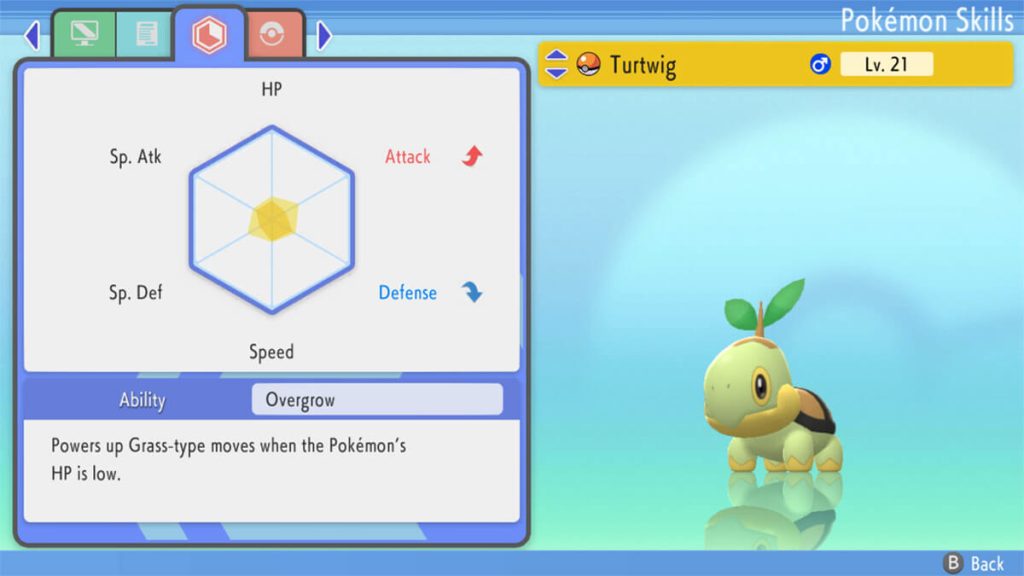In order to maximize your Pokémon’s stats, you must gain invisible points that affect the core stat attributes: HP, Attack, Defense, Special Attack, Special Defense and Speed. Normally, this happens automatically for Pokémon as they take part in trainer battles and capturing or defeating wild Pokémon. Unfortunately, this sort of “natural” gain of these points is almost never optimal for battling. This guide will help you properly EV train your Pokémon in Pokémon Brilliant Diamond and Shining Pearl. If you find that you still have questions about EV training, feel free to join our Discord server where we can help you out!
What are Effort Values (EVs)?
As mentioned above, Effort Values (EVs) are a point system that is largely invisible to players, but each EV increases a specific stat on a Pokémon. A total of 252 EVs in one stat will boost that stat to its maximum potential for that Pokémon (affected by Pokémon nature and Individual Values (IVs). The catch is that a Pokémon can only accumulate 510 EVs, meaning that you have room to max up to two stats and 6 leftover EVs which can be used to augment other stat(s).
EVs are gained each time you gain EXP for defeating a Pokémon in battle, which means the following activities will allow you to increase your Pokémon’s EVs:
- Defeating a Pokémon in a battle with an in-game Trainer
- Defeating a wild Pokémon
- Capturing a wild Pokémon
Battling against a human player online or locally will not give your Pokémon EVs.
How do you know what type of EVs you will receive after defeating a Pokémon? Will be they be awarded Attack EVs? HP EVs? Each Pokémon has a specific EV it awards (sometimes multiple) and number of EVs. Here are two examples:
- Carnivine: 2 Attack EVs
- Mothim: 1 Attack EV and 1 Special Attack EV
Defeating or capturing a Carnivine would give your Pokémon two Attack EVs, two out of 252 if you were trying to maximize your Pokémon’s attack stat. Likewise, defeating or capturing Mothim would award you two EVs, but one in Attack and one in Special Attack.
Does the experience share mechanic affect EVs?
YES! This can be good or bad, depending on your training goals. A Pokémon that wasn’t switched in won’t benefit from the lead Pokémon’s held item or PokéRus status, but will benefit if it is holding an EV-affecting item or has PokéRus itself.
How can I check my Pokémon’s EVs?
There’s no way to view the exact number of EVs your Pokémon has, but you can get an idea of how they’ve been spread out. Go to your Pokémon’s summary page, like the screenshot, and hit the ‘X’ button. The stat graph will change and you’ll be able to see a dark yellow color that denotes EV growth in the six attributes. If the EVs are maxed out, this will change to a blue color.
How to get more EVs with less effort
Certain hold items and conditions will allow you to get more EVs than normal. They are:
- Hold Items: These will affect Pokémon gaining EVs passively through the EXP share.
- Macho Brace: A Pokémon holding this item will gain a x 2 multiplier on their EV gains. This can be obtained in Pastoria City from the boy looking to see each form of Burmy. He will give it to you after you have done so.
- Power Items: A Pokémon holding one of these items will gain an additional 8 EVs each time they gain EVs. There are 6 different items, one for each stat. Make sure to read their descriptions! These can be purchased for 10 BP each at the Battle Park, a post-game area.
- Power Weight: HP
- Power Bracer: Attack
- Power Belt: Defense
- Power Lens: Special Attack
- Power Band: Special Defense
- Power Anklet: Speed
- PokéRus: This mysterious Pokémon virus grants its host with a x 2 multiplier on the EV gains! PokéRus spreads among party members when the active Pokémon makes contact with an opponent. There’s been a historical chance of 1 in 21,845 for a Pokémon contracting PokéRus after a battle.
- Active: PokéRus is only contagious if the virus is active. If a Pokémon is in your party when the clock strikes midnight, their strand of the virus becomes dormant and cannot spread! Keep an infected Pokémon in your PC to maintain access to an active strand!
- Inactive: Still applies the multiplier, but cannot be transmitted to other Pokémon.
PokéRus will stack with any held item that affects EV gains.
How to EV train your Pokémon in Brilliant Diamond and Shining Pearl
You’ve read what they are and how to check them, now it’s time to maximize your Pokémon’s stats using EV training. The main thing is to keep in mind how many points you’re adding and remember that 252 EV points in a stat will max it out. You don’t want to do extra work that isn’t necessary.
There are essentially three different methods when it comes to EV training in the Gen IV remakes.
EV training using vitamins
In Pokémon Brilliant Diamond and Shining Pearl, you are not limited in your ability to use vitamins. Each vitamin drink will give 10 EVs in a specific stat. If you have a lot of spare money, you can simply buy enough drinks to maximize your Pokémon’s EVs without doing any other battling.
HP Up: Adds 10 HP EVs
Protein: Adds 10 Attack EVs
Iron: Adds 10 Defense EVs
Calcium: Adds 10 Special Attack EVs
Zinc: Adds 10 Special Defense EVs
Carbos: Adds 10 Speed EVs
In order to achieve the 252 EVs in a single stat, you would need to use 26 items or 25 to bring the total to 250 and find a Pokémon with your desired EV and finish the training, this would be an approach to save money.
EV training using Vs. Seeker
The Vs. Seeker is a Key Item you will receive from either Dawn or Lucas when you enter Route 207 from the Cycling Road (Route 206). This item can be used to re-battle Trainers, so of which can provide great EV gains.

- HP: Route 209, 5 HP EVs per battle (45 with a held Power Weight)
- Attack: Route 214, 6 Attack EVs per battle (30 with a held Power Bracer)
- Defense: Route 212, 3 Defense EVs per battle (27 with a held Power Belt)
- Sp. Attack: Route 214, 6 Sp. Attack EVs per battle (30 with a held Power Lens)
- Sp. Defense: Route 214, 2 Sp. Defense EVs per battle (10 with a held Power Band)
- Speed: Route 205, 6 Speed EVs per battle (54 with a held Power Anklet)
EV training using wild Pokémon
Finally, you can also just hunt around in the field to find Pokémon with your desired EVs. Some locations and Pokémon are provided below, with help from PhillyBeatzU.
- HP: Bidoof, 1 HP EV. Can be found on Route 201 in abundance.
- Attack: Bibarel, Machoke, 2 Attack EVs. Can be found on Route 210 in foggy areas.
- Defense: Geodude, Hippopotas, 1 Defense EV. They are the only spawns in the Ruin Maniac Cave.
- Special Attack: Gastly, 1 Sp. Attack EV. Can be found in the Old Chateau at 100% encounter rate.
- Sp. Defense: Tentacruel, 2 Sp. Defense EVs. Can be found on Route 223 by surfing.
- Speed: Starly, 1 Speed EV. Can be found in 201 in abundance.
Although these Pokémon have low EV yields, these are locations in which they are very common and can be easily encountered in succession. By using a held “Power” item, you will receive that Pokémon’s EV value + 9, so each of the above Pokémon would be 9-10 EVs per battle. For example, if a Pokémon is holding a Power Weight, it will receive 9 HP EVs per battle with a Bidoof. In 28 Bidoof battles, it will fully max out its HP EVs.
How to remove EVs
It is not uncommon to want to remove EVs, especially if you have been using a Pokémon in your team without a thought to competitive battling. You remove already-gained EVs by using specific berries. The first berry eaten will lower the gained EVs to 100, while subsequent berries will lower by 10 EVs per berry. You’ll need a maximum of 11 berries for stats that have full EVs.
- Pomeg Berry: Removes HP EVs
- Kelpsy Berry: Removes Attack EVs
- Qualot Berry: Removes Defense EVs
- Hondew Berry: Removes Sp. Attack EVs
- Grepa Berry: Removes Sp. Defense EVs
- Tamato berry: Removes Speed EVs
You can check that all EVs have been removed by going back to your Pokémon’s stats page in their summary and using the ‘X’ button to check that the dark yellow has become a small hexagon.




